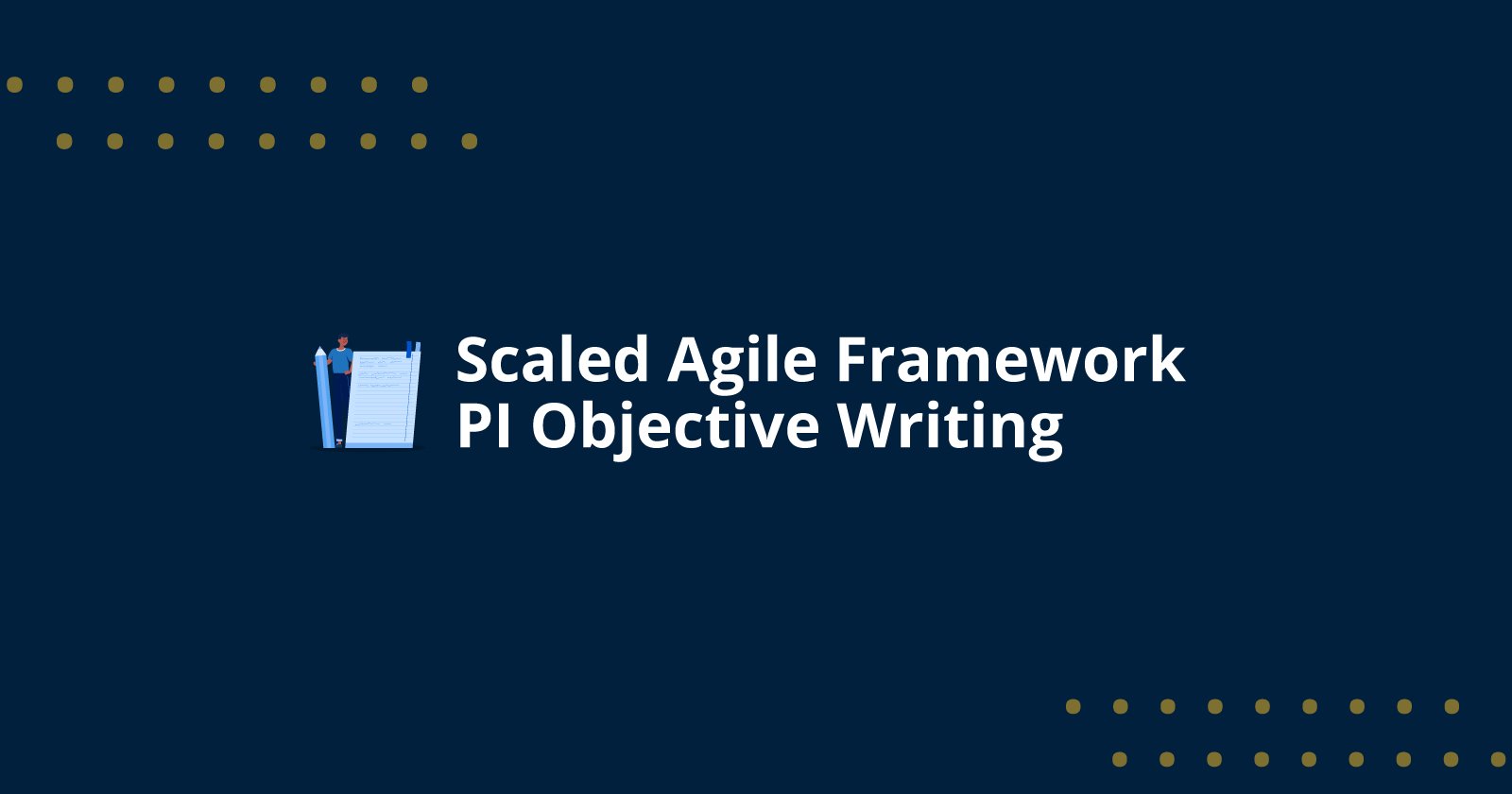In SAFe Framework, program increment (PI) is a key measure for aligning teams and delivery values in a more systematic way and synchronized manner. Another element of PI planning that has to be made is identification of PI Objectives. These objectives are crucial for guiding the teams through the program increment and achieve them with the strategic plan of the organisation.
In this blog, we will find out what are the PI objectives, why they are relevant, and how to construct PI planning in SAFe Framework.
What are PI Objectives in SAFe?
But firstly, let us define what PI objectives are and why it is important.
In SAFe, a program increment (PI) is typically an 8-12 weeks period, in which an Agile Release Train (ART) provides value. During PI planning, all the teams and stakeholders come together to discuss upcoming increments across the different teams on the same product.
PI Objectives are the targets set by teams during PI planning to achieve during the upcoming PI. These objectives are a technique of defining what the team is going to do, what is expected of it as well as the utility it seeks to offer. PI Objectives aid in enhancing clarity, focus, and alignment of the ART among all relevant stakeholders.
These objectives serve multiple purposes:
- Alignment: They assist in making sure that the teams in the ART are aligned to shared objectives.
- Visibility: PI objectives enable stakeholders to know what will be achieved and delivered.
- Commitment: They ensure the team's commitment to delivering value during the PI.
PI Objectives are broken down into two categories:
- Business Objectives: These mainly focus on customer needs and business goals.
- Technical Objectives: These focus on the internal goals such as technical debt reduction, infrastructure enhancements or new capabilities.
Also, check:SAFe Agile PI Planning Details
What are the key elements of PI objectives?
PI Objectives are clear, measurable and relevant to business strategy and technical requirements. Here are the essential elements that make PI Objectives effective:
- Clarity: PI objectives should be stated clearly. It should be easily understood by all stakeholders including both technical and non-technical team members. Avoid using professional terms and try not to complicate things. It should focus on what value the team is delivering, rather how the work is being done.
- Measurability: It is another important PI objective. It allows the team to set measurable goals where at the end of the PI, they can be able to determine if they have met that goal. Using SMART ( Specific, Measurable, Achievable, Relevant, Time-bound) criteria as a guideline to write a clear and measurable objective.
- Alignment with Business Goals: Each of the PI planning is aligned with business or strategic goals of the organisation. This way a team can be assured that it is handling the right priorities as well as deliver value to the overarching goals and objectives.
- Actionability: PI objectives are actionable, which means the work involved in achieving them is well-defined and can be broken down into smaller tasks. They make sure that teams know exactly what steps to take to accomplish the objective.
- Prioritization: Not all PI objectives are equally important. A priority should be assigned based on the business value they deliver. The PI Objectives should be the most important goals that an organization wants to achieve in line with its strategic plan.
- Stretch Goals vs. Committed Objectives: In SAFe Framework, PI objectives are divided into two categories:
- Committed Objectives: These are goals that a team can achieve, these goals are aligned with specific support and strategies.
- Stretch Objectives: These are the goals that the team wants to accomplish but is not quite sure that it is capable of achieving. Stretch objectives include an element of challenge and it is common to achieve more than targets set out for by the implementation of stretch objectives.
- Value-Oriented: Every PI objective should focus on delivering values based on the customer needs. If it is a feature, if it changes an existing process, if it is a technical solution, always check that it will help deliver a measurable value proposition to the customer.
What are the Best Practices of Writing PI Objectives?
With the basic framework down here are the tips for creating good PI Objectives:
1. Collaborate with Stakeholders
It is important not to write the PI Objectives in isolation. It is important to involve all stakeholders such as product owners, product managers, and business representatives during the PI planning session. This enhances support for the objectives as a technique in that it avoids the setting of objectives that cannot be realized for technical reasons or does not deliver enough value to the business
Discuss with the stakeholders about the key priorities of PI planning. Collect information about the customer needs, market trends, and any changes needed for the business environment. This makes sure that the objectives set down for the team reflect the strategic goals in place at the current time.
2. Focus on Value Delivery, Not Tasks
During the planning phase, it is important to analyze the work and divide it into tasks, avoid writing the objectives based on the tasks. But it is the goal that highlights the value that the team is going to bring and receive. For example:
Instead of: “Total integration of new payment gateway.”
Write: A new payment gateway needs to be added to allow customer transactions to run smoothly.
These shifts ensure the team has its attention towards customer value and result.
3. Write Clear, Actionable Language
Make sure that each PI objective is written clearly so that it is easy to understand. To be effective, objectives should not state how it will be accomplished, only what will be achieved. For example, instead of “Complete task Y,” write “Ship out task Y to improve our customer experience.”
4. Use the SAFe PI Objective Template
A useful template for writing PI Objectives includes the following structure:
Objective Title: A brief description of the objective.
Objective Description: Give a detailed description of the objective what it creates.
Metrics of Success: Clearly describe how the success is measured. Which includes defined targets like performance increase, features delivery, or other customer oriented indicators.
Dependencies or Risks: What sorts of dependencies or risks are expected to apply to the achievement of the given objective?
5. Keep the Objectives Achievable
It is great to have big goals, make sure that the objectives are achieved within the PI planning. Overloading the team with unrealistic goals can lead to burnout and frustration. The target must be to deliver increased value steadily and align goals on the basis of the business’s priorities.
6. Regularly Review and Adjust PI Objectives
The idea of PI planning should not be a one-time event. Make sure you go through the set of objectives from time to time so that one can elevate the ongoing process and make the necessary changes. Within the System Demo and Inspect and Adapt (I&A) workshops, the teams have an opportunity to validate progress and redefine goals where necessary.
7. Communicate Progress Transparently
Communication plays an important role in managing the PI planning process. Keep the information updates with all stakeholders about the progress challenges, and any changes to the objectives. Use visual tools such as Kanban boards, dashboards, and burn-down charts to track progress and communicate effectively.
Being transparent not only builds trust but also helps everyone stay aligned and focused on delivery values.
What are the benefits of PI planning?
The common benefits of PI planning includes:
- Alignment Across Teams: PI Objectives make sure that all the teams in the Agile Release Train (ART), are aligned with their common vision and do not exist in their own little worlds.
- Clear Communication: Breaking down difficult and technical goals into value propositions, the KPIs simplify the communication of goals between technical teams and business audiences.
- Focus on Value Delivery: The five PI Objectives focus on the theme of measuring progress and on making sure that important activities with clear customer relevance are achieved.
- Transparency and Accountability: By including objectives in any project, stakeholders are best placed to comprehend team commitments and assess progress.
- Motivation and Engagement: It establishes a positive relation with the organizational objectives thus improving team identity and responsibilities.
- Flexibility: Thus, the concept of committed and stretch objectives provides the possibility of effective planning at the same time with proper expectations.
In essence, PI Objectives ensure that alignment, focus and value is achieved in a systematic and coordinated format.
Example of Scaled Agile Framework PI objective writing
Agile Release Train (ART): Digital Payments Platform
Program Increment: PI Q2 2025
Business Objectives
Expand Global Payment Support
- Allow the platform to accept 5 more international currencies, reach 3 new regions by the end of PI.
Improve the accuracy of fraud identification
- Introduce artificial intelligence to improve the clients fraud identification level by 15% and decrease the number of false positives by 10%.
Optimize Checkout Process
- Minimize the cart abandonment rates by 10%, through a refocusing of the user experience in the design of the checkout funnel.
Customer Support Optimisation
- Utilize a 90% accurate FAQ chatbot that will effectively cut customer service ticket count by a quarter.
Technical Objectives
- Platform Scale Up Costs: Increase overall efficiency of the key payment processing modules by optimizing them to accommodate 30 percent more volumes of transactions, without a noticeable decline in efficiency, more perfect than before.
- Upgrade Security Protocols: Implement TLS 1.3 for all transactions since newer compliance requirements have come up in late 2022.
- Automate Performance Testing: Develop an extensive performance testing strategy to define main issues while working under high stress conditions.
Stretch Objectives
1.Introduce Voice Command Payment Options
- The second step is to devise a proof of concept and create a feature of voice-based payment processing.
2.Build a Developer API Portal
- Design an Extranet for the external developers where they will be able to access and use the APIs of the platform we are developing.
Team-Specific Objectives
1.Team Alpha (Backend Services)
- APIs should be designed to enable users to make multiple currency transactions.
- The ML fraud detection engine should then be launched and blended into the current process.
2.Team Beta (the Frontend Development Team)
- Develop the improved interface of the checkout that is to be implemented in mobile as well as the desktop version.
- However, they need to be combined with the support page and the shift to live user agents has to be smooth.
3.Team Gamma (DevOps and Infrastructure)
- The company should be able to upscale its serving capacity to meet the expected transactional growth.
- For this, it is necessary to set up monitoring graphs aimed at identifying system state and presence of deviations from standards in real mode.
Conclusion
PI Objectives are the fundamental mechanism that supports PI Planning and delivery in SAFe. When designed properly, they link people, create value, and guarantee that ECRs’ strategic objectives are achieved. By the use of proper guidelines like alignment, stakeholder engagement, and attainment of SMART criteria, teams can write PI Objectives that can positively change the system.
For more knowledge and actual training about PI Objectives and other important SAFe practices, Simpliaxis offers training programs. From their courses, delivered by experienced SAFe practitioners, you can learn the best practices for implementing SAFe frameworks and Agile transformation efforts at your organization. Enroll with Simpliaxis now, and check out their SAFe courses to gain all the knowledge you need for Agile growth.













 +1-361-998-9988
+1-361-998-9988


